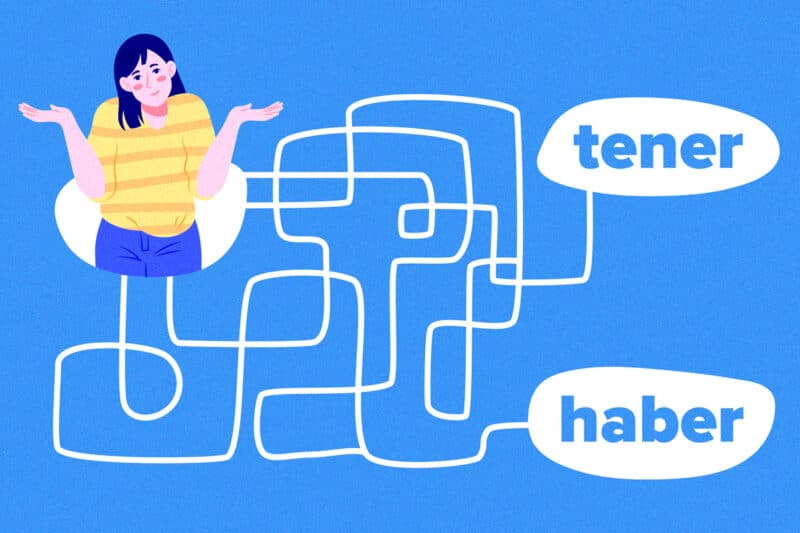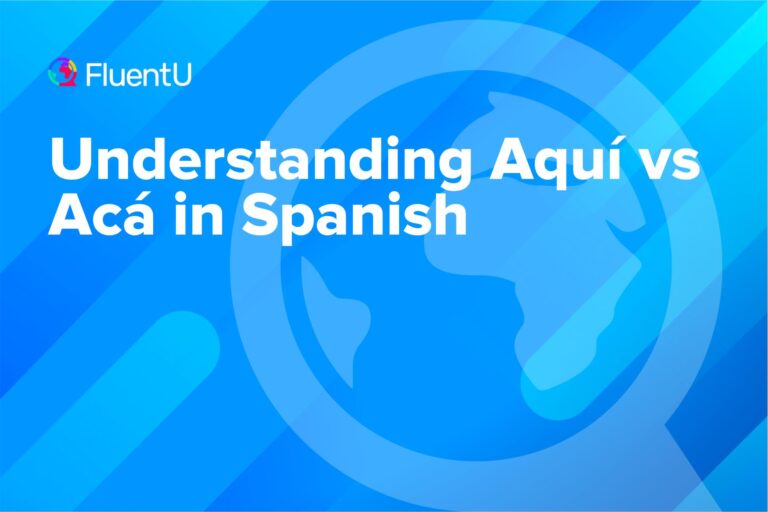Tener vs Haber: What’s the Difference?

In Spanish, there are two words for “to have.” Tener (to have) and haber (to have) are an interesting part of the Spanish language but they can also be a tad confusing, especially for beginning learners.
Thankfully, we’ve untangled the “to have” mess so you know exactly how these Spanish verbs work.
Download: This blog post is available as a convenient and portable PDF that you can take anywhere. Click here to get a copy. (Download)
Main Differences Between Tener and Haber
While both can be translated into English as “to have,” tener and haber have unique functions in Spanish.
- Tener (to have) expresses possession, age, obligation and states of being.
- Haber (to have, to be) expresses existence and can be used as a helping verb to form compound tenses.
So, how do you know which one to use? Read on for a full breakdown of their functions.
When to Use Tener in Spanish
Let’s start off with this quick lesson on tener from our YouTube channel:
Tener is an irregular verb, so it doesn’t take on the typical –er endings when it’s conjugated.
Conjugate tener in the simple present like this:
| Spanish | English |
|---|---|
| Yo tengo | I have |
| Tú tienes | You have |
| Él/ella/usted tiene | He/she/you (formal) have |
| Nosotros tenemos | We have |
| Vosotros tenéis | You (plural) have |
| Ustedes tienen | You (plural) have |
| Ellos/ellas tienen | They have |
The verb tener can be used in quite a few ways, so let’s take a look at how to employ it.
To show possession
First, use tener to say that you have something.
Tengo las entradas de béisbol en mi bolso.
(I have the baseball tickets in my purse.)
Tienen helado.
(They have ice cream.)
To talk about appearance
When you want to comment on an appearance, such as a physical detail, use the verb tener.
Mi abuela tiene ojos grises.
(My grandmother has gray eyes.)
Ese hombre de la bicicleta tiene una linda sonrisa.
(That man on the bicycle has a nice smile.)
To express age
Use tener to say how old someone or something is.
Yo tengo 25 años.
(I am 25 years old.)
Su perro tiene tres años.
(His dog is three years old.)
To show states of being
Tener is also used to express bodily states, feelings or emotions.
Yo tengo frío.
(I am cold.)
Tenemos miedo de esa casa espeluznante.
(We are scared of that creepy house.)
To talk about illness
Similarly, tener is used to discuss pain and illness, much like we use “have” in English.
Ella tiene dolor de cabeza.
(She has a headache.)
Luis se va a ir a su casa porque tiene dolor de estómago.
(Luis is going to go home because he has a stomachache.)
To express obligation
When you want to say that something has to be done, use the phrase tener que.
Nosotros tenemos que ir a la playa.
(We have to go to the beach.)
Rosa tiene que hacer su tarea.
(Rosa has to do her homework.)
To say “I feel like…”
And finally, use the phrase tener ganas de to say “I feel like…” in Spanish.
Tengo ganas de ir a nadar.
(I feel like going swimming.)
Ana tiene ganas de cenar comida italiana.
(Ana feels like having Italian food for dinner.)
When to Use Haber in Spanish
Like tener, haber is also an irregular verb.
But don’t fret! Here’s how to conjugate it in the simple present:
| Spanish | English |
|---|---|
| Yo he | I have |
| Tú has | You have |
| Él/ella/usted ha | He/she/you (formal) have |
| Nosotros hemos | We have |
| Vosotros habéis | You (plural) have |
| Ustedes han | You (plural) have |
| Ellos/ellas han | They have |
For a full conjugation of haber, check out this post.
Haber has two primary functions, which we’ll look at now.
Haber as an impersonal verb
One form of haber means “there is” or “there are.” Hay is a tiny but mighty word—Spanish speakers use it all the time!
Hay un coche grande en la calle.
(There is a big car in the street.)
Hay muchas bicicletas amarillas en el parque.
(There are many yellow bicycles in the park.)
Haber as an auxiliary verb
Haber can also function as an auxiliary or “helper” verb to form compound tenses in Spanish. That means it accompanies the main verb of a sentence to form a verb phrase.
Together, the two verbs are used to express an action that has been or will be completed.
Ha bailado en el teatro.
(He has danced in the theatre.)
Ellos ya se han ido.
(They have already gone.)
Resources to Practice Tener vs Haber
There’s no denying it. The tener vs haber challenge is one of the most intricate bits of Spanish grammar.
But you’ll get the hang of it. All you need to do is practice!
- Quia has a fun, fast-paced little game where you can practice using tener. This game is great for small pockets of spare time.
- With FluentU you can look up any word—like tener and haber—in FluentU’s dictionary to see the definition, videos that use the word in context and example sentences.
FluentU takes authentic videos—like music videos, movie trailers, news and inspiring talks—and turns them into personalized language learning lessons.
You can try FluentU for free for 2 weeks. Check out the website or download the iOS app or Android app.
P.S. Click here to take advantage of our current sale! (Expires at the end of this month)

- Spanish to Learn Free asks you to type the answers to complete each blank. With no options available, you can really see how well you know the tested words.
- Sporcle’s time challenge asks learners to choose the correct answers for fill-in-the-blank sentences. You’ll gain valuable skills by learning to think quickly and respond without hesitation.
- Study.com offers practice with tener and its usage. Click on the “Lesson” or “Course” tabs to expand your knowledge of this important verb.
Tener and haber are used daily in conversations, music and television. They’re essential backbones of the Spanish language.
Get familiar with their grammar rules and use these two verbs often.
With enough practice, you’ll “have” it eventually—I promise!
And One More Thing…
If you've made it this far that means you probably enjoy learning Spanish with engaging material and will then love FluentU.
Other sites use scripted content. FluentU uses a natural approach that helps you ease into the Spanish language and culture over time. You’ll learn Spanish as it’s actually spoken by real people.
FluentU has a wide variety of videos, as you can see here:

FluentU brings native videos within reach with interactive transcripts. You can tap on any word to look it up instantly. Every definition has examples that have been written to help you understand how the word is used. If you see an interesting word you don’t know, you can add it to a vocab list.

Review a complete interactive transcript under the Dialogue tab, and find words and phrases listed under Vocab.

Learn all the vocabulary in any video with FluentU’s robust learning engine. Swipe left or right to see more examples of the word you’re on.

The best part is that FluentU keeps track of the vocabulary that you’re learning, and gives you extra practice with difficult words. It'll even remind you when it’s time to review what you’ve learned. Every learner has a truly personalized experience, even if they’re learning with the same video.
Start using the FluentU website on your computer or tablet or, better yet, download the FluentU app from the iTunes or Google Play store. Click here to take advantage of our current sale! (Expires at the end of this month.)








